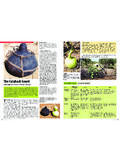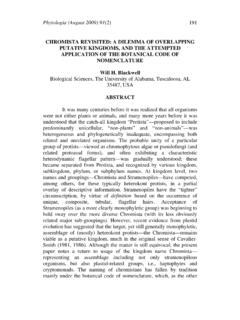Transcription of Naturescaping - Missouri Botanical Garden
1 Visit us on the Web: Naturescaping An appreciation of our natural landscape leads many of us to want to capture nature s beauty in our home gardens. Naturescaping is a landscaping approach that focuses on working with the natural character of the land, rather than trying to transplant species that are not native or adapted to the natural conditions. In short, Naturescaping is the arrangement of native plants in the Garden in a way similar to their arrangement in nature. Naturescaping provides many benefits to the home gardener including the opportunity to integrate nature into our daily lives and bring conservation closer to home. By recreating the prairie, meadow or woodland which once characterized your region, you can rediscover the past, promoting a sense of place and a tie to the land where you live.
2 Native plants make excellent landscape plantings because they are adapted to the local weather and soil conditions. Consequently, they require little or no fertilizer, are relatively low maintenance and help conserve scarce resources such as water and energy. Native plants are also less frequently bothered by insect and disease problems thus reducing the need for chemical controls. The principal of Naturescaping relies on increased species diversity and natural predation to keep pest populations in check. Pesticide use is strongly discouraged as it harms beneficial insects such as lady bugs, dragon flies and praying mantis. Pesticide use also reduces pollinator and local butterfly populations significantly. One of the most important reasons for using native plants in the landscape is to increase public awareness about saving native organisms and their habitats.
3 A Garden of native plants preserves habitat for many native birds, insects and mammals that are becoming as rare as the plants and natural environments that feed and shelter them. Native Plants in the Home Landscape You can create a beautiful Garden with native plants wherever you live. Begin by determining how you want to use native plants in your Garden . The most important rule of thumb is to choose plants that will tolerate the conditions available in your landscape. Height, color and time of bloom are also important considerations when selecting native plants for the home landscape. Learn to recognize the native plants that may already exist in your Garden such as phlox, black-eyed Susan, butterfly weed, coreopsis, bee balm, deciduous holly and viburnum. On a small scale, you can incorporate a few favorite natives into existing plantings.
4 Or you can devote an entire Garden or landscape to native plants. For gardeners who wish to devote a large portion of their landscape to native plantings, it is helpful first to explore local native plant communities. Conservation organizations, such as the Missouri Department of Conservation, can help you find natural plant communities to explore. Urban gardeners who may not have the room to recreate an entire plant community can still create the essence of the community by using the dominant native plants as the backbone of their landscape design. Some municipalities may have height restrictions in regard to vegetation. Be sure to check local weed ordinances before beginning any Naturescaping project. Conservation and the Home Landscape The recent enthusiasm for Naturescaping has created a demand for a wide range of native plants.
5 In some cases, these plants are collected from the wild rather than propagated in a nursery. In order to conserve our native flora, gardeners should purchase nursery-propagated plants only. There are several ways to ensure that the plants you purchase are nursery propagated. Check plant labels and catalogs for information on the source of the plant. Beware of ambiguous phrases such as nursery-grown which could mean that the plant was dug from the wild and then transplanted in the nursery. Get to know your nursery person and ask questions about plant production. Price can be a good indicator. Plants, such as Trillium spp. that take several years to grow from seed, will cost far less when dug from the wild. Some plants that are particularly prone to poaching include cacti, orchids, insectivorous plants and medicinal plants.
6 A satisfying and easy way to acquire natives is to collect seeds and grow your own. If you decide to collect seed from the wild, follow ethical practices and never collect more seed than you can grow. Always get landowner permission before collecting on private property. While collecting seed of common wildflowers is acceptable, it is extremely harmful to natural populations of rare and endangered species. In Missouri , contact the Department of Conservation for collection regulations and a list of threatened and endangered plants. Planting Your Native Wildflower Garden The Perennial and Mixed Border Native plants will coexist quite happily with non-natives in the perennial or mixed border. When combining native and non-native plants in the same Garden area, be certain to group together plants that have the same specific cultural requirements.
7 Choose woodland wildflowers for the shade Garden or gardens located in moist or wet areas; chose meadow, prairie or glade wildflowers for the sunny Garden . When incorporating natives into existing plantings, it is advisable to purchase containerized plants. Follow the planting directions provided by the nursery. While plants may be purchased through mail-order, it is best to buy plants from a local source whenever possible. These plants are more likely to be genetically adapted to your region s climate and other environmental conditions. Woodland Wildflowers Woodland wildflowers will be best suited to your landscape if your yard is shady and wooded. Most woodland wildflowers prefer well-drained soil, light shade and adequate moisture. They will also benefit from a soil high in organic matter as well as a leaf mulch that persists throughout the year.
8 There are several things to consider before purchasing woodland wildflowers for the home landscape. First, determine whether your wooded area contains wet or dry shade. Rocky outcroppings, white oaks and hickory trees are good indicators of dry shade conditions. Season of bloom is another important consideration in the woodland Garden ; as many of the woodland wildflowers are spring ephemerals with short-lived bloom periods. Woodland wildflowers are best purchased as containerized plants which establish themselves more reliably than plants started from seed. Finally, select plants from a local nursery as they are more likely to be suited to the growing conditions in your area. Native Missouri Plants for the Woodland Garden *denotes dry shade Botanical Name Common Name Height (in ft.)
9 Bloom Period Bloom Color Grasses Chasmanthium latifolium Northern Sea Oats 3 Aug-Oct beige *Hystrix patula Bottlebrush Grass 3 Aug-Oct beige Shrubs Aesculus pavia Red Buckeye 16 April-June red Cephalanthus occidentalis Buttonbush 5-7 June-August white Cornus amomum Silky Dogwood 10 June yellowish white Corylus americana (dry or moist) American Hazelnut 9 Feb-April red/light yellow Lindera benzom Spice Bush 15 March-April yellow *Symphoricarpos orbiculatus Coralberry 6 July-August green/pink violet Wildflowers Amsonia tabemaemontana Blue Star 3 April-May blue Anemone canadensis White Anemone 1 May-July white *Anemonella thalictroides Rue Anemone April-May white, pale pink *Aquilegia canadensis Columbine 1-2 April-July scarlet/yellow Arisaema triphyllum Jack-in-the Pulpit 1-3 May-June purple.
10 White Asarum canadense Wild Ginger April-May brown *Aster anomalis Weird Aster 2-3 blue *Aster patens Spreading Aster 2-3 blue Chelone obliqua Rose Turtlehead 2-4 pink Cimicifuga americana Bugbane 2-4 white Dicentra cucullaria Dutchman's Breeches 1-2 March-May white *Echinacea purpurea Purple Coneflower 3 May-Oct. pinkish purple Erythronium albidum Dogtooth Violet March-May bluish-white *Geranium maculatum Cranesbill Geranium 1-2 April-June pink, blue Heuchera richardsonii Alum Root 1 April-July green Iris cristata Crested Iris 1 April-May purple, blue *Monarda bradburiana Horsemint 2 May-June pink Mertensia virginica Bluebells 2 March-June pink, blue *Phlox divaricata Wild Sweet William 1 April-June purple, blue Polygonatum biflorum Solomon's Seal 3-6 May-June white Sanguinaria canadensis Bloodroot March-May white *Scutellaria incana Downy Skullcap 3-4 July-August blue *Silene caroliniana Wild Pink April-May rose.
















